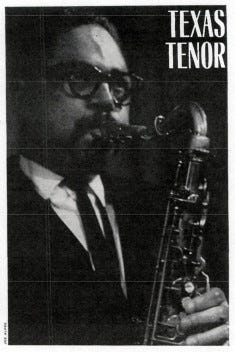"Booker Ervin - Texas Tenor"
Copyright ® Steven Cerra, copyright protected; all rights reserved.
“Booker Ervin (b Denison, TX, 31 Oct 1930; d New York, 31 Aug 1970) was the son of a trombonist who worked for a time with Buddy Tate, and he inherited his father's instrument: between the ages of eight and 13 he played trombone. He taught himself to play saxophone while in the air force (1950—53), then studied music in Boston for two years. His first professional engagement was with Ernie Fields's rhythm-and-blues band, with which he made his earliest recordings (c!956). Ervin rose to prominence as a member of Charles Mingus's group (1958-62). He also worked frequently in a cooperative quartet, the Playhouse Four, with Horace Parlan, George Tucker, and Al Harewood, and with Randy Weston. His best work as a leader was on nine albums recorded for Prestige (1963—6).”
Mark Gardner The New Grove Dictionary of Jazz
“Originally a trombone player, Ervin taught himself saxophone while in the services and instinctively veered towards the kind of blunt, blues-soaked sound of fellow-Texans like Arnett Cobb and Illinois Jacquet. He had his big break with Mingus, who liked his raw, unaffected approach. The career was painfully short, but Booker packed a lot in. He's still missed.”
Richard Cook and Brian Morton, The Penguin Guide to Jazz on CD, 6th Ed.
“Booker Erwin is a powerful, swinging, story-teller.”
Ira Gitler, insert notes to Booker Ervin
During a recent listening of tenor saxophonists Booker Ervin and Zoot Sims on Booker’s The Book Cooks [Bethlehem Avenue Jazz R2 76691], I was really taken by the difference in sound that each got on the same instrument.
While Zoot’s tone was its usual bright, buoyant and bouncy self, Booker’s was darker, denser and more driving; one floated over the rhythm while the other pushed through it.
Hailing from Denison, Texas it’s easy to associate Booker’s style with the big bluesy, and wailing style that has become known as the Tenor Tenor Sound, a sound that the late Julian Cannonball Adderley once described as “the tone within the moan.”
Or as Leonard Feather and Ira Gitler describe it in The Encyclopedia of Jazz: “With a sound as big as the great outdoors, and a tidal rhythmic drive, he was in the lineage of the Texas Tenors.”
While Booker’s approach to Jazz improvisation was certainly rooted in The Blues it seemed more expansive and more expressive. But what were the qualities that made it so?
I thought it might be fun to share some observations by other Jazz writers and critics whose ideas about Booker’s approach to Jazz helped shed light on my quest to know more about how he achieved his singularity.
Sadly, Booker didn’t have long to share his secrets as he died in 1970 at the age of 40!
Let’s start with this piece by Bill Coss which appeared in the July 8, 1962 edition of Downbeat.
Keep reading with a 7-day free trial
Subscribe to CerraJazz Substack to keep reading this post and get 7 days of free access to the full post archives.




